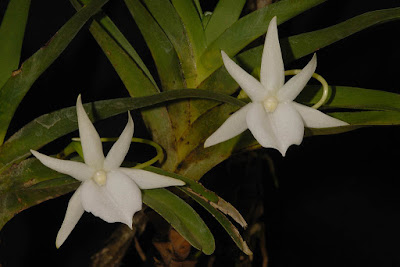Angraecum curnowianum is found in Madagascar. It grow in humid forest in the mountains of the central eastern part of the island near Antananarivo at 1000-1200 m.
Angraecum curnowianum also called as Curnow's Angraecum, Aerangis curnowiana, Aeranthes curnowianus, Angorchis curnowiana, Angraecum suarezense, Angraecum subcordatum, Jumellea curnowiana, Jumellea subcordata, Mystacidium curnowianus, Perrierangraecum curnowianum, Rhaphidorhynchus curnowianus, is a species of the genus Angraecum. This species was described by T.Durand & Schinz in 1894.
IDENTIFY ANGRAECUM CURNOWIANUM ORCHID PLANT
Angraecum curnowianum is found in Madagascar. It grow in humid forest in the mountains of the central eastern part of the island near Antananarivo at 1000-1200 m.
It is a miniature sized, 15-25 cm tall, warm to cool growing epiphyte with a short stem carrying a fan of 7, ligulate, emarginate, thick, fleshy, dark dull green, rough, 12-13 cm long, 2.2-2.3 cm wide leaves.
Curnow's Angraecum blooms in the summer through fall on an axillary, 3 to 3.5 cm long, single flowered inflorescence with 2 to 3 basal, obtuse, acute sheaths carrying a fleshy flower.
ANGRAECUM CURNOWIANUM ORCHID PLANT CARE AND CULTURE
Cultural information should only be used as a guide, and should be to be adapted to suit you. Your physical location; where you grow your plants, how much time you have to devote to their care, and many other factors, will need to be taken into account. Only then can you decide on the cultural methods that best suit you and your plants.
Light:
Angraecum curnowianum needs a light level of 12000-18000 lux. Plants require shady conditions and initiate flower spikes even in extremely low light. They should be protected from high light. Strong air movement should be provided at all times.
Temperature:
Summer days temperature at average 28-29°C, and nights temperature at average 18°C, with a diurnal range of 9-11°C.
Humidity:
Curnow's Angraecum need the humidity of 75–80% most of the year, dropping to 65-70% for about 4 months in late winter and spring.
Substrate, growing media and repotting:
Angraecum curnowianum seem to grow better when mounted on slabs of cork with a pad of sphagnum under the base of the plant. The plants must dry out between misting, however, and mounted plants should be misted or drenched 4-6 times per week. If pots must be used, a very open medium that allows good air movement around the roots should be used, and the plant must dry out between waterings. Baskets or undersized clay pots probably produce better results than do plastic pots. Repotting should be done just as new root growth is starting in order for the plant to become established in the shortest possible time.
Watering:
Rainfall is moderate to very heavy from late spring to autumn. Average rainfall then drops rapidly into a five–month dry season that starts in late autumn and lasts until early spring. Cultivated plants should be watered heavily while actively growing, but their roots must dry rapidly after watering.
Fertilizer:
1/4–1/2 recommended strength, applied weekly. A high-nitrogen fertilizer is beneficial from spring to midsummer, but a fertilizer high in phosphates should be used in late summer and autumn.
Rest period:
Winter days temperature at average 22-23°C, and nights average 11-12°C, with a diurnal range of 11-12°C. Angraecum curnowianum plants need less water in late autumn through winter, but they should be watered periodically to prevent excessive drying. Occasional early-morning misting between infrequent light waterings should provide sufficient moisture in most growing areas. Water should be increased somewhat if leaves shrivel or show signs of stress. Fertilizer should be eliminated until new growth starts and heavier watering is resumed in spring.















COMMENTS